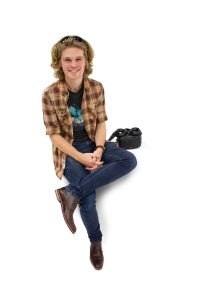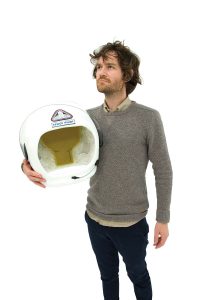The software and digital tools they use are the new generation of equipment and epitomise the spirit of creative media production.
So what is the programme all about?
The Bachelor of Creative Media Production degree covers four distinctive pathways in animation and visual effects, film and television, game development and, lastly, web and interactive development including virtual, mixed and artificial reality.
Students are initially taught the skills and techniques required to produce content across the pathways. As the programme progresses students are supported in broadening their knowledge and understanding of new and emerging platforms and given critical support in producing work.
The head of School, Associate Professor Andre Ktori, says that in the final year of the programme, students work with external organisations to produce content and experience a real-work environment in terms of production and client handling.
Earlier this year the school announced a new partnership for this purpose with TVNZ, post-production and content creator POW Studios, Te Papa Tongarewa and many others.
“It’s truly significant in that we are now offering programmes that allow access to state-of-the-art production and technical equipment. With that comes access to industry that is interested in working with graduates who are already familiar with the technology,” he says.
The School has $18 million high-tech facilities such as motion / performance capture studio with green screen, a dubbing theatre and screening room, edit suites, animation and digital video production suites and games labs.

Another of this year’s graduates, Dylan Richardson works as a junior game designer at Pik Pok, which publishes games for smartphone, tablets and desktops.
“As a kid I was always into creative toys like Lego, and putting things together and making stuff, and it eventually in

late primary school/intermediate school my video game phase started and it’s fair to say never really ended.
I have always had a passion for it, particularly inter-active story telling, which is kind of my niche.”
For last year’s end-of-year Exposure exhibition of work by final-year students at the College, his team created an adventure video game that involved using the environment to overcome the perils of the wilderness and solving puzzles to escape danger.
He sees the opportunity to try most of the courses offered within creative media production with helping him to find that niche.
“During my studies I did some animation and games classes. Even a bit of film. I got to try out motion capture and VR (virtual reality) too.” VR technologically isolates a user from the real world to create a fabricated one.
The programme also allowed Richardson to learn more about media studies and even take an elective in Japanese.
Chris Chalmers has taken a more off-beat trajectory in his approach to the degree.
Describing himself as a multi-skilled creative with a focus on directing , art design, editing and sound design, Chalmers adds he has a passion for “producing exciting, interesting and sometimes weird content.”
His web series Lance, what have you Done? which he filmed, scripted and stars in, is the story of an introverted pet photographer who accidentally kills a gang member’s beloved dog. It shows the absurdist influences of his favourite filmmakers including Monty Python, awkward comedy duo Tim & Eric and the film noir of David Lynch.
It’s a formula that clearly works. Last year Chalmers was awarded the Screen Production and Development Association Big Pitch competition for the web series, judged by celebrated New Zealand film director Jane Campion. He has already had interest expressed in his work by several producers.
Where Chalmers is making his name with his own home-grown characters, animator Kate Lambert is doing similar with the re-booted and re-named Thunderbirds Are Go series.
Working for Stirling Road Productions, part of Pukeko Pictures, she does continuity checks, ensuring that there are no inconsistencies or blemishes in the look of the show, across the animation, lighting and composition.
She credits her time at Massey for giving her the depth to step straight into work on a show beloved by millions worldwide.
“In the final year of Creative Media Production I specialised in 3D animation so this job is perfect because it allows me to see every step of the animation process and I am learning a lot.”
In many ways Lambert’s childhood served as an apprenticeship for her profession. She spent hours watching DVDs’ special features
on the making of the Harry Potter movies, and fed her love of music through the film soundtracks all while learning classical piano, which she still plays.
“Growing up I also made a lot of videos with my friends, I would always be behind the camera giving direction and making them act out silly things. I made a lot of stories on PowerPoint from taking pictures around home and using transitioning effects on PowerPoint to animate inanimnate objects and turning them into characters.”
These include her own Exposure exhibit, a 3D animation Tinker, which also served as an apprenticeship for her current role with Thunderbirds Are Go.
“I still can’t believe I’ve ended up here working on Thunderbirds [which is also a childhood favourite of her father’s]; it’s all still very exciting for me.”
Ktori says excitement and technological evolution represents the school’s ethos.
“The 21st century is all about cross-media and change. Games, apps, web, film animation, visual effects, audio, they are morphing rapidly. The Bachelor of Creative Media Production sets graduates up for the new world with industry experience, critical grounding and practical know-how, so they hit the ground running and have the flexibility to push boundaries.”